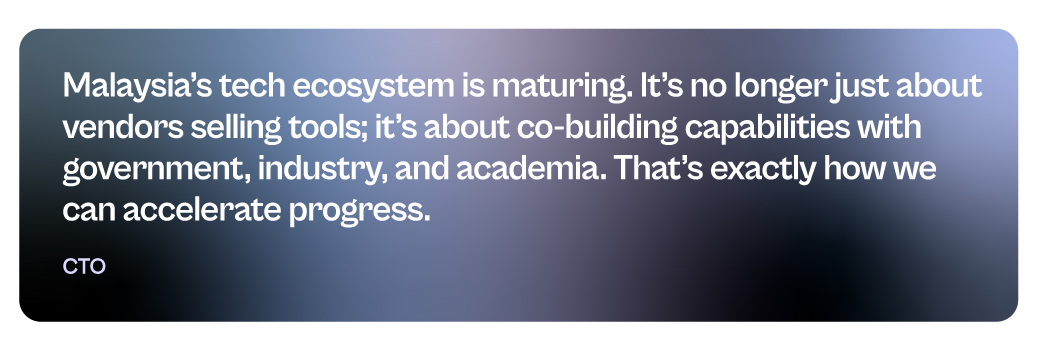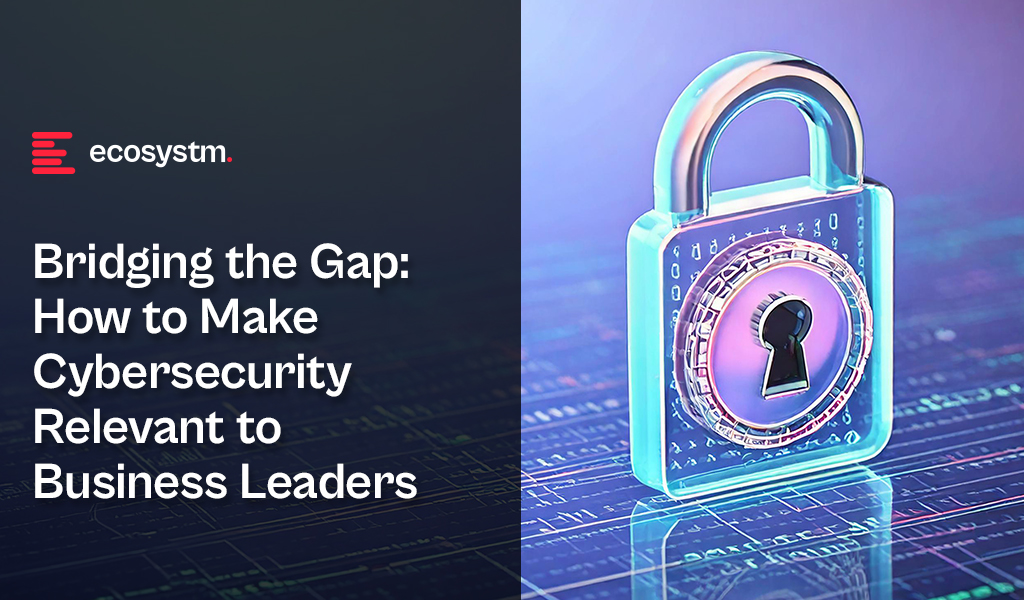Digital transformation in Malaysia has entered a new phase: less about bold roadmaps, more about fixing what’s broken. With the digital economy expected to reach 25.5% of GDP by 2025, the challenge now is turning strategy into results. Leaders aren’t chasing the next big thing – they are focused on integration bottlenecks, talent gaps, and showing real ROI.
The technology isn’t the problem; it’s making it stick. AI, cloud, and data platforms only deliver value when backed by the right systems, skills, and governance. From aviation to agriculture, organisations are being forced to rethink how they work, how they hire, and how they measure success.
Through a series of interviews and roundtable conversations with Malaysian business and tech leaders, Ecosystm heard firsthand what’s driving – and holding back – digital progress. These weren’t polished success stories, but honest reflections on what it really takes to move forward. The five themes below highlight where Malaysia’s transformation is gaining ground, where it’s getting stuck, and what’s needed to close the gap between ambition and execution.
Theme 1. Ecosystem Collaboration Is Driving Malaysia’s Digital Momentum
Malaysia’s digital transformation is being shaped not by individual breakthroughs, but by coordinated momentum across government, industry, and technology providers. This ecosystem-first approach is turning national ambitions into tangible outcomes. Flagship initiatives like JENDELA, Digital Nasional Berhad’s 5G rollout, and cross-agency digital infrastructure programs are laying the groundwork for smarter public services, connected industries, and inclusive digital access.
The Ministry of Digital (MyDigital) is taking a central role in aligning AI, 5G, and cybersecurity efforts under one roof – helping speed up policy execution and improve coordination between regulators and the private sector. Major tech players like Microsoft, Google, Nvidia, and AWS are responding with expanded investments in local cloud regions, chip design collaborations, and foundational AI services designed for Malaysian deployment environments.
What’s emerging is not just a policy roadmap, but a digitally integrated economy – where infrastructure rollouts, vendor innovation, and government leadership are advancing together. As Malaysia targets to create 500,000 new jobs and reach over 80% 5G population coverage, the strength of these partnerships will be critical in ensuring national strategies translate into sector-level execution.

Theme 2. Laying the Groundwork for Malaysia’s AI Economy
With over 90% of online content projected to be AI-generated by 2025, Malaysia faces growing urgency to ensure that the systems powering AI development are secure, interoperable, and locally relevant. This is about more than data sovereignty – it’s about building the infrastructure to support scalable, trusted, and sector-wide AI adoption.
The National AI Office (NAIO), under MyDigital, is leading efforts to align infrastructure with national priorities across healthcare, manufacturing, agriculture, and public services. Initiatives include supporting domestic data centres, enabling cross-sector cloud access, and establishing governance frameworks for responsible AI use.
The priority is no longer just adopting AI tools, but enabling Malaysia to develop, fine-tune, and deploy them on infrastructure that reflects local needs. Control over this ecosystem will shape how AI delivers value — from national security to inclusive fintech. To support this, Budget 2025 allocates USD 11.7 million for AI education and USD 4.2 million for the National AI Framework. Programs like AI Sandboxes, alongside emerging public-private partnerships, are helping bridge gaps in talent and tooling.
Together, these efforts are laying the foundation for an AI economy that is scalable, trusted, and anchored in Malaysia’s long-term digital ambitions.

Theme 3. Malaysia’s Enterprise AI Landscape: Still in Its Early Stages
Malaysian enterprises are actively exploring AI to drive competitiveness, but widespread, production-grade adoption remains limited. While leading banks are leveraging AI for fraud detection and digital onboarding, and manufacturers are exploring predictive maintenance and automation, many companies face barriers in scaling beyond pilots. Core challenges include siloed data systems, unclear return on investment, and limited in-house AI talent. Even when tools are available, businesses often lack the capacity to integrate them meaningfully into workflows.
Cost is another concern. AI implementation, especially when reliant on third-party platforms or cloud infrastructure, can be prohibitively expensive for mid-sized firms. Without a clear link to bottom-line improvement, AI investments are frequently deprioritised. There’s also lingering uncertainty around governance and compliance, which can further slow enterprise momentum.
For AI to scale across Malaysia, enterprise strategies must align with operational realities – offering cost-effective, localised solutions that deliver measurable value and inspire long-term confidence in digital transformation.

Theme 4. Building on Regulation to Achieve True Cyber Resilience
Malaysia is ramping up its cybersecurity strategy with a stronger regulatory backbone and ecosystem-wide initiatives. The upcoming Cyber Security Bill introduces mandatory breach notifications, sector-specific controls, and licensing for Managed Security Operations Centres (SOCs). Agencies like NACSA are driving protections across 11 critical sectors, while the Cybersecurity Centre of Excellence (CCoE) in Cyberjaya is scaling SOC analyst training in partnership with international players. These efforts are complemented by Malaysia’s leadership role in IMPACT, the UN’s cybersecurity hub, and participation in ASEAN-wide resilience initiatives.
Despite this progress, enterprise readiness remains inconsistent. Malaysian businesses faced an average of 74,000 cyberattacks per day in 2023, yet many still rely on outdated playbooks and fragmented systems. Cybersecurity is often viewed through a compliance lens – meeting audit requirements rather than preparing for real-time recovery. Investments are still skewed toward perimeter defences, while response protocols, cross-team coordination, and real-time observability are underdeveloped.
True resilience requires a shift in mindset: cybersecurity must be treated as a board-level business function. It must be operationalised through simulations, automated response frameworks, and enterprise-wide drills. In a threat landscape that is both persistent and sophisticated, Malaysia must evolve from regulatory compliance to strategic continuity – where recovery speed, not just prevention, becomes the defining metric of cyber maturity.

Theme 5. Malaysia’s Digital Transformation Is Being Led by Industry, Not Policy
While national strategies like the New Industrial Master Plan 2030 set out broad ambitions, real AI-led transformation in Malaysia is taking shape from the ground up, driven by industrial leaders tackling operational challenges with data. Manufacturing and Energy firms, which together contribute over 30% of Malaysia’s GDP, are ahead of the curve. Leaders are using AI for predictive maintenance, digital twins, logistics optimisation, and emissions tracking, often outpacing regulatory requirements.
In some cases, cloud platforms now process millions of machine data points daily to reduce downtime and lower costs at scale. What sets these firms apart is their focus on well-integrated, usable data. Rather than running isolated pilots, they’re building interoperable systems with shared telemetry, open APIs, and embedded analytics, with a focus on enabling AI that adapts in real time.
Malaysia’s next leap in transformation will hinge on whether the data discipline seen in leading industries can be replicated across less-digitised sectors.
If we consider Agriculture – still contributing 7-8% of GDP and employing nearly 10% of the workforce – we find that it remains digitally fragmented. While drones and IoT devices are collecting NDVI and soil data, much of it remains siloed or underutilised. Without clean data pipelines or national integration standards, AI struggles to move from demonstration to deployment.

A Moment to Redefine Ambition
Malaysia stands at a point where digital ambition must evolve into digital maturity. This means asking harder questions – not about what can be built, but what should be prioritised, sustained, and scaled. As capabilities deepen, the challenge is no longer innovation for its own sake, but ensuring technology serves long-term national resilience, equity, and competitiveness. The decisions made now will shape not just digital progress – but the kind of economy and society Malaysia becomes in the decade ahead.

Cybersecurity is essential to every organisation’s resilience, yet it often fails to resonate with business leaders focused on growth, innovation, and customer satisfaction. The challenge lies in connecting cybersecurity with these strategic goals. To bridge this gap, it is important to shift from a purely technical view of cybersecurity to one that aligns directly with business objectives.
Here are 5 impactful strategies to make cybersecurity relevant and valuable at the executive level.
1. Elevate Cybersecurity as a Pillar of Business Continuity
Cybersecurity is not just a defensive strategy; it is a proactive investment in business continuity and success. Leaders who see cybersecurity as foundational to business continuity protect more than just digital assets – they safeguard brand reputation, customer trust, and operational resilience. By framing cybersecurity as essential to keeping the business running smoothly, leaders can shift the focus from reactive problem-solving to proactive resilience planning.
For example, rather than viewing cybersecurity incidents as isolated IT issues, organisations should see them as risks that could disrupt critical business functions, halt operations, and destroy customer loyalty. By integrating cybersecurity into continuity planning, executives can ensure that security aligns with growth and operational stability, reinforcing the organisation’s ability to adapt and thrive in a constantly evolving threat landscape.
2. Translate Cyber Risks into Business-Relevant Insights
To make cybersecurity resonate with business leaders, technical risks need to be expressed in terms that directly impact the organisation’s strategic goals. Executives are more likely to respond to cybersecurity concerns when they understand the financial, reputational, or operational impacts of cyber threats. Reframing cybersecurity risks into clear, business-oriented language that highlights potential disruptions, regulatory implications, and costs helps leadership see cybersecurity as part of broader risk management.
For instance, rather than discussing a “data breach vulnerability”, frame it as a “threat to customer trust and a potential multi-million-dollar regulatory liability”. This approach contextualises cyber risks in terms of real-world consequences, helping leadership to recognise that cybersecurity investments are risk mitigations that protect revenue, brand equity, and shareholder value.
3. Build Cybersecurity into the DNA of Innovation and Product Development
Cybersecurity must be a foundational element in the innovation process, not an afterthought. When security is integrated from the early stages of product development – known as “shifting left” – organisations can reduce vulnerabilities, build customer trust, and avoid costly fixes post-launch. This approach helps businesses to innovate with confidence, knowing that new products and services meet both customer expectations and regulatory requirements.
By embedding security in every phase of the development lifecycle, leaders demonstrate that cybersecurity is essential to sustainable innovation. This shift also empowers product teams to create solutions that are both user-friendly and secure, balancing customer experience with risk management. When security is seen as an enabler rather than an obstacle to innovation, it becomes a powerful differentiator that supports growth.
4. Foster a Culture of Shared Responsibility and Continuous Learning
The most robust cybersecurity strategies extend beyond the IT department, involving everyone in the organisation. Creating a culture where cybersecurity is everyone’s responsibility ensures that each employee – from the front lines to the boardroom – understands their role in protecting the organisation. This culture is built through continuous education, regular simulations, and immersive training that makes cybersecurity practical and engaging.
Awareness initiatives, such as cyber escape rooms and live demonstrations of common attacks, can be powerful tools to engage employees. Instead of passive training, these methods make cybersecurity tangible, showing employees how their actions impact the organisation’s security posture. By treating cybersecurity as an organisation-wide effort, leaders build a proactive culture that treats security not as an obligation but as an integral part of the business mission.
5. Leverage Industry Partnerships and Regulatory Compliance for a Competitive Edge
As regulations around cybersecurity tighten, especially for critical sectors like finance and infrastructure, compliance is becoming a competitive advantage. By proactively meeting and exceeding regulatory standards, organisations can position themselves as trusted, compliant partners for clients and customers. Additionally, building partnerships across the public and private sectors offers access to shared knowledge, best practices, and support systems that strengthen organisational security.
Leaders who engage with regulatory requirements and industry partnerships not only stay ahead of compliance but also benefit from a network of resources that can enhance their cybersecurity strategies. Proactive compliance, combined with strategic partnerships, strengthens organisational resilience and builds market trust. In doing so, cybersecurity becomes more than a safeguard; it’s an asset that supports brand credibility, customer loyalty, and competitive differentiation.
Conclusion
For cybersecurity to be truly effective, it must be woven into the fabric of an organisation’s mission and strategy. By reframing cybersecurity as a foundational aspect of business continuity, expressing cyber risks in business language, embedding security in innovation, building a culture of shared responsibility, and leveraging compliance as an advantage, leaders can transform cybersecurity from a technical concern to a strategic asset. In an age where digital threats are increasingly complex, aligning cybersecurity with business priorities is essential for sustainable growth, customer trust, and long-term resilience.




